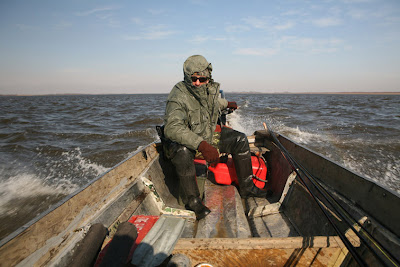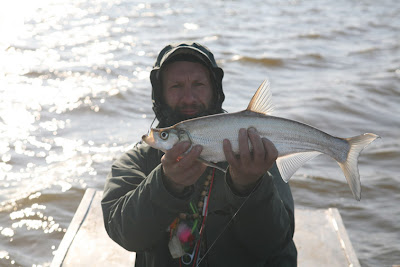Urmi is 458 km long river which is joining the Kur River of the similar size. The result of this marriage is a mighty 90 km long river named Tunguska. Tunguska River is floating into the Amur River from its left bank, on the opposite bank from Khabarovsk.
In October I was with my friend Sergey in the middle reaches of the Urmi River, upstream from the Kukan village. After a 90 km long trip on a beaten dirt road from the city of Birobidzhan we are pumping up a 15' inflatable motor boat.
In October I was with my friend Sergey in the middle reaches of the Urmi River, upstream from the Kukan village. After a 90 km long trip on a beaten dirt road from the city of Birobidzhan we are pumping up a 15' inflatable motor boat.
In this area the Urmi is 20-60 meters wide stream, swift and clear. The river has many log jams, so some of its channels are tricky to navigate even with a jet-boat.
In the lower part of a tributary named Kosmun' there were lots of different graylings.
"Lower Amur type" grayling is living in the middle reaches of the rivers; downstream from the lower limit of the habitats of this species in summer there will be no other Salmonids.
This is another species, so called "yellow-spotted grayling". It is relative to the "Upper Amur type" grayling. In the Lower Amur River this species is sympatric (living together) with the "Lower Amur type" grayling, but its habitats are different. The yellow-spotted grayling in summer is populating the swift upper reaches of the rivers on higher elevations. This species is migrating down into the middle reaches of the streams only in the late fall.
The next morning was morose and foggy. A deep cyclone was coming, threatening with the rain by the next evening. The fish was not feeding, so it was rather hard to catch anything bigger than grayling. This is a sharp-nose species of lenok.
A slightly bigger blunt-nose lenok was caught with a 5 cm long pink wobbler-fly, presented deep.
A tiny cabin of a trapper at the bank of the Urmi River.
Below this rapid Sergey had found some lenok.
This small taimen was caught with a lure and released. We are releasing taimen which is becoming rare in many areas of the Far East.





















































